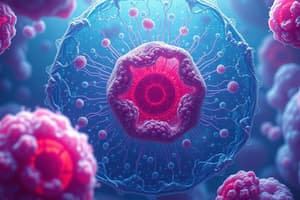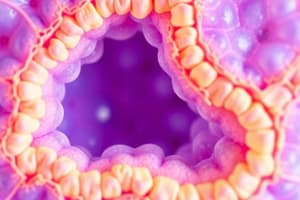Podcast
Questions and Answers
Which cell type is NOT one of the four main types of human tissues?
Which cell type is NOT one of the four main types of human tissues?
- Neurons
- Muscle cells
- Epithelial cells
- Cartilage cells (correct)
What is the primary function of epithelial tissue in the skin?
What is the primary function of epithelial tissue in the skin?
- Secretion
- Protection (correct)
- Absorption
- Diffusion
Which type of epithelial tissue is characterized by tightly packed cells with little matrix?
Which type of epithelial tissue is characterized by tightly packed cells with little matrix?
- Connective tissue
- Nervous tissue
- Muscle tissue
- Epithelial tissue (correct)
Which subtype of epithelial tissue can be keratinized or non-keratinized?
Which subtype of epithelial tissue can be keratinized or non-keratinized?
What kind of glands consist of a single cell, like goblet cells?
What kind of glands consist of a single cell, like goblet cells?
Which epithelial tissue is specialized for absorption in the gastro-intestinal system?
Which epithelial tissue is specialized for absorption in the gastro-intestinal system?
What is the function of the basement membrane in epithelial tissue?
What is the function of the basement membrane in epithelial tissue?
Which type of epithelium contains cilia and is often found in the respiratory tract?
Which type of epithelium contains cilia and is often found in the respiratory tract?
What type of gland secretes directly into the bloodstream without using ducts?
What type of gland secretes directly into the bloodstream without using ducts?
Which type of connective tissue has a gel-like matrix and binds organs together?
Which type of connective tissue has a gel-like matrix and binds organs together?
What is the primary function of fibroblasts in connective tissue?
What is the primary function of fibroblasts in connective tissue?
Which type of cartilage is characterized by numerous elastic fibers and is found in the auricle of the ear?
Which type of cartilage is characterized by numerous elastic fibers and is found in the auricle of the ear?
Which of the following is a characteristic of adipose tissue?
Which of the following is a characteristic of adipose tissue?
What distinguishes merocrine glands from apocrine glands?
What distinguishes merocrine glands from apocrine glands?
What is the primary content of the intercellular matrix in connective tissue?
What is the primary content of the intercellular matrix in connective tissue?
Which type of connective tissue is characterized by a hard matrix with mineral salts?
Which type of connective tissue is characterized by a hard matrix with mineral salts?
During which type of ossification do bones form from mesenchymal tissue concentration?
During which type of ossification do bones form from mesenchymal tissue concentration?
Which cell type is primarily involved in promoting inflammation and producing histamine in connective tissue?
Which cell type is primarily involved in promoting inflammation and producing histamine in connective tissue?
Flashcards are hidden until you start studying
Study Notes
Epithelial Tissue
- Covers the body and lines cavities and ducts
- Reproduces quickly and cells are tightly packed with little matrix
- Functions:
- Protection (skin, gastrointestinal system)
- Secretion (glands)
- Absorption (gastrointestinal system)
- Excretion (kidneys)
- Filtration (kidneys)
- Diffusion (lungs)
- Sensory reception (olfactory epithelium)
Types of Epithelial Tissue
- Squamous: Flattened cells
- Cuboidal: Cube-shaped cells
- Columnar: Tall, column-shaped cells
- Simple: Single layer of cells
- Stratified: Multiple layers of cells
Specific Epithelial Tissue Types
-
Simple Squamous Epithelium: Single layer of flattened cells, found in areas of diffusion and filtration, e.g., lining of blood vessels, alveoli of lungs.
-
Stratified Squamous Epithelium: Multiple layers of flattened cells, provides protection against abrasion, found in skin and lining of vagina.
- Keratinized: Contains keratin, a protein that makes the tissue tough and water-resistant, found in skin.
- Non-keratinized: Does not contain keratin, found in lining of vagina.
-
Simple Cuboidal Epithelium: Single layer of cube-shaped cells, involved in secretion and absorption, found in glands and lining of kidney tubules.
-
Simple Columnar Epithelium: Single layer of tall, column-shaped cells, often contain cilia or microvilli, involved in secretion and absorption, found in lining of digestive tract and respiratory tract.
-
Pseudostratified Columnar Epithelium: Single layer of column-shaped cells that appear to be stratified, often have cilia, involved in secretion and movement of mucus, found in lining of trachea.
-
Transitional Epithelium: Multiple layers of cells that can stretch and change shape, found in lining of urinary bladder.
Glands
-
Unicellular glands: Single-celled glands, e.g., goblet cells produce mucus necessary in digestive, respiratory, urinary, and reproductive systems.
-
Multicellular glands: Classified by structure and function:
- Structural Classification:
- Simple: Unbranched ducts
- Compound: Branched ducts
- Tubular: Secretory portion is tubular
- Alveolar (acinar): Secretory portion is spherical
- Functional Classification by Type of Secretion:
- Merocrine: Secretion released by exocytosis, e.g., sweat glands.
- Apocrine: A portion of the cytoplasm is released along with the secretion, e.g., mammary glands.
- Holocrine: The entire cell is released as secretion, e.g., sebaceous glands.
- Structural Classification:
-
Endocrine glands: Secrete hormones directly into the bloodstream, have no ducts.
-
Exocrine glands: Secrete substances through ducts to the surface of the body, e.g., sweat glands, salivary glands.
Connective Tissue
-
Binds structures together, provides framework and support for organs, and stores fat.
-
Cells are separated by a large amount of extracellular matrix.
-
Matrix consists of:
- Ground Substance: Amorphous jelly
- Fibers:
- Collagenous fibers: Provide strength and flexibility
- Yellow (Elastic) fibers: Provide elasticity and recoil
- Reticular fibers: Form delicate networks of support
-
Cells:
- Fibroblasts: Produce components of the matrix
- Mast cells: Involved in inflammation, produce heparin and histamine.
- Macrophages: Phagocytize bacteria and cellular debris.
- Lymphocytes: Involved in immune response.
- Plasma cells: Produce antibodies.
- Eosinophils: Involved in allergic reactions and parasitic infections.
-
Reproduces less rapidly than epithelial tissue.
Types of Connective Tissue
-
Loose connective tissue: Soft, contains collagenous and elastic fibers in a gel-like matrix, found between muscles, beneath the skin, and binds organs together.
-
Adipose (fat) tissue: Cells store fat, little intercellular matrix, cushions, insulates, and stores energy.
-
Dense fibrous connective tissue: Matrix filled with parallel bundles of collagenous fibers, binds structures together, found in tendons, ligaments, and capsules of organs.
-
Supporting Connective Tissue: Includes cartilage and bone.
-
Cartilage: Contains chondrocytes (cartilage cells) within lacunae (spaces).
- Hyaline Cartilage: Solid matrix with scattered cells and fibers, found in ends of long bones, tracheal rings.
- Fibrocartilage: Numerous collagenous fibers in matrix, found in intervertebral disks.
- Elastic Cartilage: Numerous elastic fibers, provides flexibility, found in auricle of the ear.
-
Bone (Osseus Connective Tissue): Hard matrix with mineral salts, osteocytes (bone cells) in lacunae.
- Compact Bone: Shaft of long bones, parallel plates of flat bones. Contains structural unit called Haversian system, with Haversian canals and Volkmann's canals. Matrix arranged in lamellae (layers) around central canal.
- Spongy Bone: Ends of long bones, center of irregular bones. No Haversian system.
-
Bone Formation:
- Intramembranous Ossification: Formation of bone directly from mesenchymal tissue, occurs in bones of skull and clavicle.
- Endochondral Ossification: Formation of bone from a cartilage model, occurs in long bones.
Studying That Suits You
Use AI to generate personalized quizzes and flashcards to suit your learning preferences.




